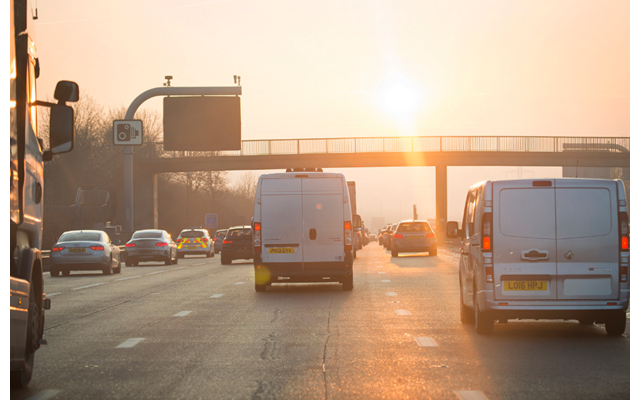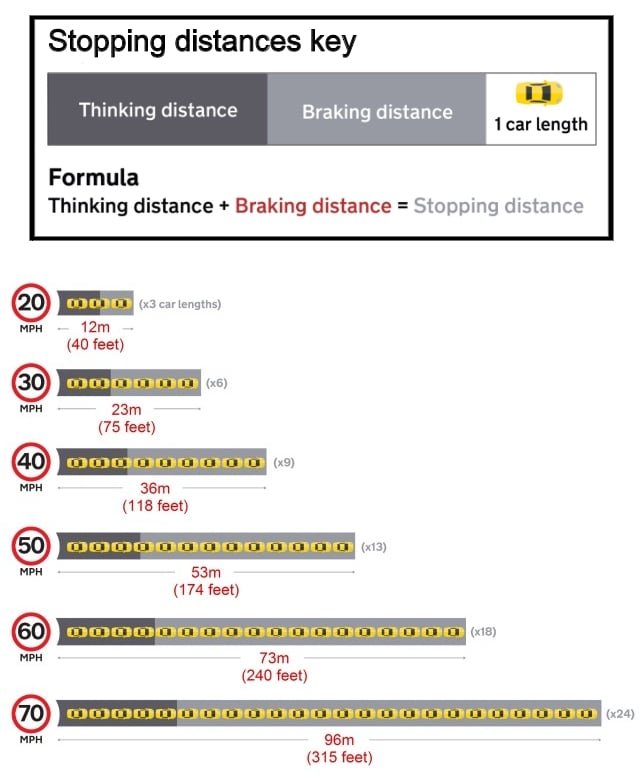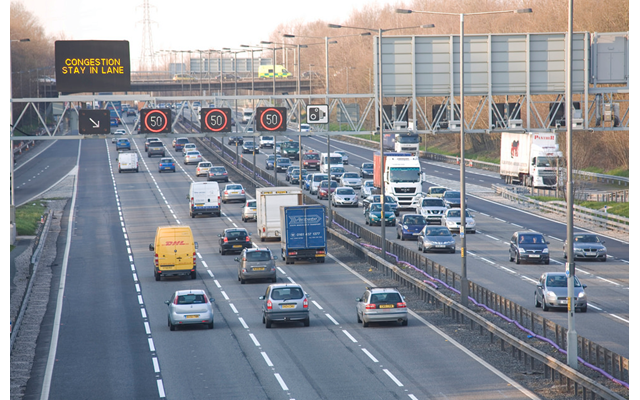
We're all sometimes guilty of driving too fast for the conditions and too close to other cars. (Although we hate it when it happens to us. Tailgating is the top peeve of drivers, according to our Member surveys.)
But to be a safe driver, it's important to understand stopping distances. Whether you're studying for your theory test or you passed years ago, it's worth revising.
Leaving enough distance between you and the car in front will:
- Give you a better view of the road ahead.
- Let you react and stop in time if cars ahead suddenly brake.
- Help with fuel economy - you'll drive more smoothly and won't be braking every time the car in front slows down.
Read on to learn how much stopping distance you should leave.
We provide 24/7 roadside assistance.
What is stopping distance?
Stopping distance is the time that it takes to bring a moving car to a complete stop. This includes
- The time it takes you to react to the hazard (thinking distance), and
- The time it takes for the brakes to stop the car (braking distance)
You can calculate it with this stopping distance formula:
Stopping distance = thinking distance + braking distance
How much stopping distance should I leave?

When driving, you should leave enough clear distance in front of you to be able to come to a stop. This is in case the traffic suddenly slows down, causing you to brake.
However, stopping distances vary depending on factors like the weather and your driving speed.
| The stopping distance will increase the faster you drive and the wetter the road is. It also takes time to process what's happening before you start braking. |
The Highway Code shows this by splitting the typical stopping distance up into thinking distance and braking distance. You'll need to remember the distances for your theory test.
The distances are based on the average car length in the UK and assume the road is dry.
Stopping distances at different speeds
| Speed | Thinking + braking distance | Stopping distance |
| 20mph | 6m + 6m | 12m (40 feet) |
| 30mph | 9m + 14m | 23m (75 feet) |
| 40mph | 12m + 24m | 36m (118 feet) |
| 50mph | 15m + 38m | 53m (174 feet) |
| 60mph | 18m + 55m | 73m (240 feet) |
| 70mph | 21m + 75m | 96m (315 feet) |
The stopping distance at 20mph is around 3 car lengths. At 50mph it's around 13 car lengths. If you're travelling at 70mph, the stopping distance will be more like 24 car lengths.
What is thinking distance?
This is the distance your car travels between you spotting a hazard and starting to brake.
If the car in front slams on their brakes, then no matter how hard you try, you won't be able to brake immediately. It'll take you time (and distance) to react to what's happening, decide to brake, and then hit the pedal.
The Highway Code bases its thinking distances on a thinking time of just under 0.7 seconds. The faster you're going, the further you'll travel in that time.
The thinking distance at 50mph is 15m, nearly the length of 2 London buses. At 70mph, the thinking distance will be about 21m.
What can affect thinking distance?
Besides your speed, other factors can affect your reaction time too:
1. Drugs and alcohol
- Drinking and taking drugs both slow down your reaction time.
- Slower reactions increase the distance covered before you react to danger ahead.
2. Distractions
- If you're not completely focused on the road ahead then it'll take you longer to react.
- Sat-navs, mobile phones and other in-car tech can distract drivers.
- It's illegal to hold a mobile to call or text while driving. But even a hands-free call can take your mind off the road.
- Talking to passengers and fiddling with the radio or heating can also divide your attention.
3. Tiredness
- Lack of sleep severely affects driver attention, awareness and reaction time.
- On longer journeys, you should take a break every couple of hours.
- Research has shown that after driving for 2 hours you'll be less able to concentrate and slower to react.
-
All these factors affect how quickly you react and hit the brakes when you spot a hazard. Once you brake, your stopping distance will depend your car's upkeep as well as the road and weather conditions.

What is braking distance?
This is the distance your car will travel once you hit the brakes before it comes to a complete stop.
For the same car under the same conditions, the braking distance will increase as your speed goes up. That's why the Highway Code gives typical braking distances for a range of speeds.
The braking distance at 50mph is 38m - almost twice as long as a cricket pitch. The braking distance at 70mph is a huge 75m, which is about 9 London buses.
What can affect braking distances?
You should leave at least the recommended distance when driving a well-maintained car with good road and weather conditions. However, many factors can increase braking distance. For peace of mind while on the road, our breakdown cover can provide you with 24/7 Roadside Assistance.
1. Brakes:
- The condition of the car's brakes will affect braking distance, so keep them in good working order.
- ABS brakes won't significantly reduce braking distance (they can actually increase it on snow or gravel). But they do allow you to keep control and steer while braking.
- Worn suspension will increase the distance, as weight transfer while braking affects performance.
2. Tyres
- Different tyres have different wet and dry grip depending on their tread pattern and the rubber used.
- All new tyres include a wet grip rating on the label, which goes from A (best) to G (worst).
- Tests have shown that tyres with only 3mm of tread travel about a third further before stopping than new tyres. So check your tyre tread to make sure they're not too worn.
- Braking is also affected by tyre pressure. Both under- and over-inflation will increase braking distance.
Find out more:
3. Weather conditions
- If the road is wet or icy, this will significantly increase braking distances.
- Double the gap between your car and the car in front when it's wet.
- Leave an even bigger gap if it's icy - some advice says 10 times bigger.
4. Road conditions
- A damaged or muddy road surface will increase braking distance.
5. Weight
- The braking distance will also increase if the car is heavier.
The 2-second rule
The 2-second rule is a good rough guide to check that you're leaving enough stopping distance. Here's how it works:
- Choose a fixed point on the road ahead.
- Watch when the vehicle in front of you passes that point.
- Make sure it's at least 2 seconds or more before you pass the same fixed point.
- That way, you're probably keeping a safe distance.
This is a good rule of thumb for car stopping distances in dry conditions, but if it's wet you should double the gap to 4 seconds.
Remember that it's only a rough guide and there's a margin for error. At lower speeds, 2 seconds will see you further back than the Highway Code stopping distances. But at higher speeds, you'll be considerably closer.
Do stopping distances need to be updated?
Theory tests have used the same stopping distances for decades, even though cars and their brakes are more advanced now.
Some people think we should reduce stopping distances to account for the improvements. Others say we should increase them because drivers face more distractions these days.
Either way, these guidelines have proved effective so far. And there's no sign of them changing anytime soon.
Published: 11 Aug 2017 | Updated: 23 Jan 2020
